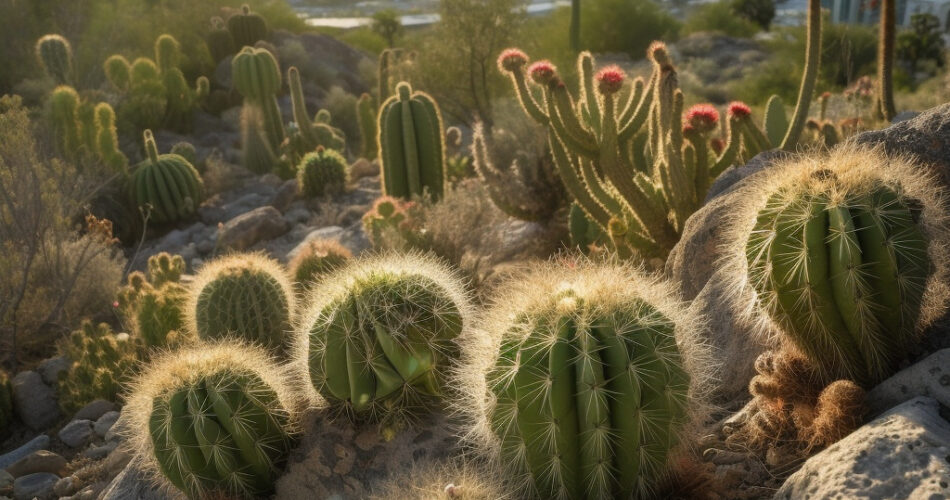Key Takeaways:
- Adaptations that help cacti thrive in harsh conditions include their ability to withstand extreme temperatures, their thick cuticle to prevent water loss, and their spines that provide shade and defense.
- Cacti conserve water through their ability to store it in their stems and leaves, and they minimize water loss through a specialized form of photosynthesis called CAM.
- Cacti store water efficiently with specialized cells called parenchyma cells and have an extensive network of vascular tissue for water transport.
- Cacti play a crucial role in maintaining ecosystem stability in arid regions as keystone species, contributing to soil conservation and moisture retention, and influencing local biodiversity.
- Climate change poses significant threats to cactus populations, and conservation efforts, habitat preservation, and sustainable land management practices are essential for their preservation.
- Cacti can be cultivated for aesthetics and sustainability, such as in xeriscaping for low-water landscaping, designing gardens based on climate zones, and developing cacti-based horticulture for sustainable plant cultivation.
Survival Strategies of Cacti in Challenging Environments
When it comes to thriving in harsh and unforgiving environments, few plants can rival the resilience of cacti. These iconic succulents have evolved a range of adaptations that allow them to survive and even thrive in some of the harshest conditions on Earth.
1. Adaptations That Help Cacti Thrive in Harsh Conditions
One of the key adaptations that enable cacti to survive in challenging environments is their ability to withstand extreme temperatures. Cacti have a thick, waxy outer layer, called a cuticle, that helps to prevent water loss and protect against dehydration. Additionally, many cacti have specialized structures known as spines, which serve multiple purposes. These spines not only act as a defense mechanism against herbivores but also help to shade the cactus from intense sunlight, reducing water loss through evaporation.
Another crucial adaptation of cacti is their ability to carry out photosynthesis even with their stomata closed during the hottest parts of the day. Unlike most plants, cacti can open their stomata at night when temperatures are lower and carbon dioxide is more readily available. They can then store this carbon dioxide and use it during the daytime to carry out photosynthesis without losing excessive amounts of water.
2. Unique Features That Enable Cacti to Conserve Water
Water conservation is essential for cactus, as they often inhabit arid regions with limited water availability. One important feature that helps cacti conserve water is their ability to store it in their stems and leaves. Many cacti have thick, fleshy stems that can hold significant amounts of water, allowing them to survive for extended periods without rainfall. Some cacti also have modified leaves, known as cladodes, which serve as additional water storage structures.
In addition to their water storage abilities, cacti have developed a unique mechanism for minimizing water loss through transpiration. Unlike most plants, cacti have a specialized form of photosynthesis called crassulacean acid metabolism (CAM). This process allows them to absorb carbon dioxide at night when the air is cooler and humidity is higher, reducing the need for them to open their stomata during the day and consequently limiting water loss.
3. How Cacti Store Water for Extended Periods
One of the remarkable abilities of cacti is their capacity to store water for extended periods without access to rainfall. The presence of specialized cells called parenchyma cells allows cacti to store water efficiently. These cells can expand and contract as they store or release water, enabling the cactus to adjust its water content based on the availability of water in its environment.
Additionally, cacti have developed an extensive network of vascular tissue that helps transport water throughout the plant. This network enables cacti to efficiently collect and distribute water from their roots to the rest of the plant, ensuring it reaches all the necessary parts.
The Role of Cacti in Maintaining Ecosystem Stability
While cacti’s ability to survive in challenging environments is impressive, their importance extends beyond their own survival. Cacti play a crucial role in maintaining ecosystem stability in arid regions.
1. Cacti as Keystone Species in Arid Regions
Cactus are often considered keystone species in arid regions, meaning they have a disproportionate impact on their ecosystem compared to their abundance. Their presence or absence can significantly affect the balance of the entire ecosystem. Many desert animals rely on cacti for food, water, and shelter. By providing these resources, cacti support a wide range of species, including insects, birds, reptiles, and mammals.
2. Cacti’s Contribution to Soil Conservation and Moisture Retention
The unique architecture of cacti, with their extensive root systems, helps prevent soil erosion in arid regions. The roots of cacti spread out and hold the soil together, reducing the risk of desertification. Additionally, cacti can effectively trap and retain moisture in the soil, making it available for other plants and organisms in the ecosystem.
3. Cacti’s Influence on Local Biodiversity
Cacti provide a diverse range of microhabitats within their environments, creating niches for other plant species to thrive. These microhabitats offer protection from harsh weather conditions and shelter from predators, allowing a greater variety of plant species to coexist in arid regions. This, in turn, supports a more diverse community of insects, birds, and other small animals.

Protecting Cactus Populations in the Face of Changing Climate
Despite their remarkable adaptations, cacti are not immune to the challenges posed by climate change. Rising temperatures, changing precipitation patterns, and increased frequency of extreme weather events all pose significant threats to cactus populations.
1. Understanding the Impact of Climate Change on Cacti Survival
Scientists are actively studying the impact of climate change on cacti and their ecosystems. Research suggests that rising temperatures can negatively affect cacti’s reproductive success, as some species require specific temperature ranges for successful pollination and seed germination. Changes in precipitation patterns can also lead to water stress in cacti, affecting their growth and survival.
2. Implementing Conservation Efforts to Preserve Cacti Species
To protect cactus populations, conservation efforts focused on habitat preservation and species reintroduction are crucial. Establishing protected areas and enforcing regulations to prevent habitat destruction can help safeguard cactus populations. Additionally, captive breeding programs and seed banks can serve as insurance against the loss of genetic diversity and provide a means to reintroduce threatened species into the wild.
3. Promoting Sustainable Land Management Practices in Cactus Habitats
Encouraging sustainable land management practices in cactus habitats is essential for their long-term survival. Implementing measures to reduce soil erosion, such as controlled grazing and reforestation, can help maintain the integrity of cactus habitats. Additionally, promoting sustainable agriculture practices that minimize water use and avoid the use of chemical pesticides and fertilizers can protect both cacti and the broader ecosystem.
Creating Green Oases: Cultivating Cacti for Aesthetics and Sustainability
Beyond their ecological significance, cacti also have aesthetic value and can be cultivated to create beautiful and sustainable landscapes.
1. Utilizing Cacti in Xeriscaping for Low-Water Landscaping
Cacti are excellent choices for xeriscaping, a landscaping technique that aims to reduce water usage and create low-maintenance gardens. Their ability to store water and withstand drought conditions makes them ideal for environments where water scarcity is a concern. By incorporating cacti into xeriscaped gardens, homeowners can create visually appealing landscapes while conserving water.
2. Designing Cacti Gardens to Thrive in Different Climate Zones
Cacti are incredibly diverse, with thousands of species adapted to various climatic conditions. By carefully selecting cacti species that are well-suited to the specific climate of a region, gardeners can create thriving cacti gardens that require minimal maintenance and irrigation. Whether it’s a desert garden or a coastal succulent display, designing cacti gardens based on climate zones ensures their long-term success.
3. Developing Cacti-based Horticulture for Sustainable Plant Cultivation
As interest in sustainable gardening practices grows, so does the potential for cactus-based horticulture. The cultivation of cacti for commercial purposes, such as the production of food, medicine, and ornamental plants, can provide economic opportunities while also promoting sustainable plant cultivation. Traditional knowledge of cacti cultivation can be combined with modern techniques to develop sustainable and profitable horticulture systems.
FAQ
Question: How do cacti survive in harsh conditions?
Cacti have several adaptations that enable them to thrive in challenging environments. They can withstand extreme temperatures, thanks to their thick cuticle that prevents water loss and their spines that provide shade. They also have the ability to carry out photosynthesis even with closed stomata during the hottest parts of the day.
Question: How do cacti conserve water?
Cacti conserve water through their ability to store it in their stems and leaves. They have fleshy stems that can hold significant amounts of water, allowing them to survive without rainfall for extended periods. Additionally, cacti have a specialized form of photosynthesis called CAM that helps minimize water loss.
Question: How do cacti store water for extended periods?
Cacti store water efficiently through specialized cells called parenchyma cells. These cells can expand and contract as they store or release water, allowing the cactus to adjust its water content based on the availability in its environment. Cacti also have an extensive network of vascular tissue that helps transport water throughout the plant.
Question: What role do cacti play in ecosystem stability?
Cacti are considered keystone species in arid regions, meaning they have a significant impact on their ecosystems. They provide food, water, and shelter for many desert animals, supporting a wide range of species. Cacti also contribute to soil conservation, moisture retention, and influence local biodiversity by creating microhabitats for other plant species.
Question: What threats do cacti face due to climate change?
Climate change poses significant threats to cactus populations. Rising temperatures can affect their reproductive success, and changes in precipitation patterns can lead to water stress. These factors can impact their growth and survival.
Question: How can cacti populations be protected?
To protect cactus populations, conservation efforts focused on habitat preservation and species reintroduction are essential. Establishing protected areas, enforcing regulations, and implementing captive breeding programs can help safeguard cactus populations and their genetic diversity.
Question: How can cacti be cultivated for aesthetics and sustainability?
Cactus can be utilized in xeriscaping for low-water landscaping, as they are well-suited to drought conditions. Designing cacti gardens based on climate zones ensures their success. Additionally, cacti-based horticulture can be developed for sustainable plant cultivation, including food, medicine, and ornamental plants.




Comments